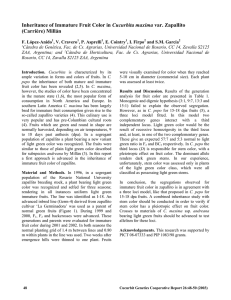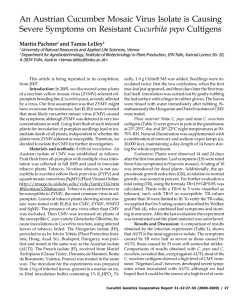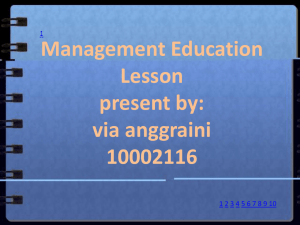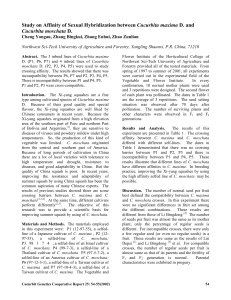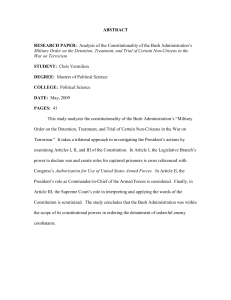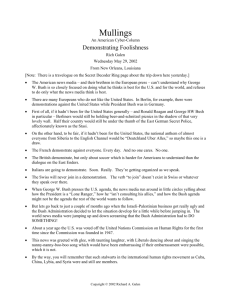Two Lines Through an Interspecific Cross Cucurbita moschata
advertisement
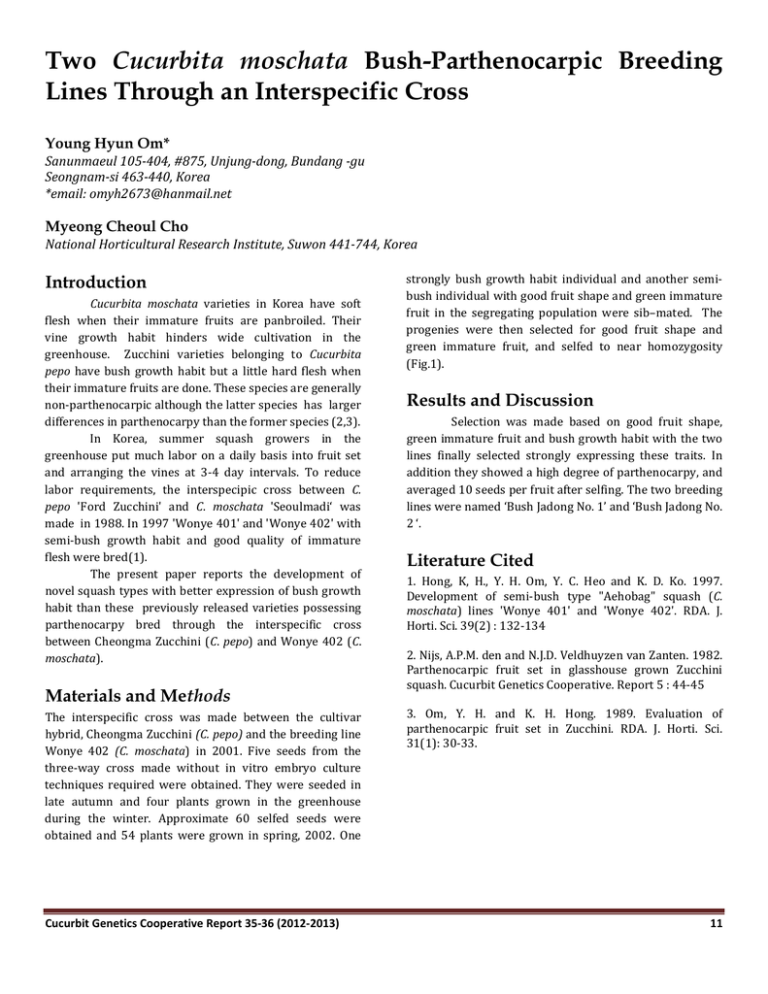
Two Cucurbita moschata Bush-Parthenocarpic Breeding Lines Through an Interspecific Cross Young Hyun Om* Sanunmaeul 105-404, #875, Unjung-dong, Bundang -gu Seongnam-si 463-440, Korea *email: omyh2673@hanmail.net Myeong Cheoul Cho National Horticultural Research Institute, Suwon 441-744, Korea Introduction Cucurbita moschata varieties in Korea have soft flesh when their immature fruits are panbroiled. Their vine growth habit hinders wide cultivation in the greenhouse. Zucchini varieties belonging to Cucurbita pepo have bush growth habit but a little hard flesh when their immature fruits are done. These species are generally non-parthenocarpic although the latter species has larger differences in parthenocarpy than the former species (2,3). In Korea, summer squash growers in the greenhouse put much labor on a daily basis into fruit set and arranging the vines at 3-4 day intervals. To reduce labor requirements, the interspecipic cross between C. pepo 'Ford Zucchini' and C. moschata 'Seoulmadi‘ was made in 1988. In 1997 'Wonye 401' and 'Wonye 402' with semi-bush growth habit and good quality of immature flesh were bred(1). The present paper reports the development of novel squash types with better expression of bush growth habit than these previously released varieties possessing parthenocarpy bred through the interspecific cross between Cheongma Zucchini (C. pepo) and Wonye 402 (C. moschata). Materials and Methods The interspecific cross was made between the cultivar hybrid, Cheongma Zucchini (C. pepo) and the breeding line Wonye 402 (C. moschata) in 2001. Five seeds from the three-way cross made without in vitro embryo culture techniques required were obtained. They were seeded in late autumn and four plants grown in the greenhouse during the winter. Approximate 60 selfed seeds were obtained and 54 plants were grown in spring, 2002. One Cucurbit Genetics Cooperative Report 35-36 (2012-2013) strongly bush growth habit individual and another semibush individual with good fruit shape and green immature fruit in the segregating population were sib–mated. The progenies were then selected for good fruit shape and green immature fruit, and selfed to near homozygosity (Fig.1). Results and Discussion Selection was made based on good fruit shape, green immature fruit and bush growth habit with the two lines finally selected strongly expressing these traits. In addition they showed a high degree of parthenocarpy, and averaged 10 seeds per fruit after selfing. The two breeding lines were named ‘Bush Jadong No. 1’ and ‘Bush Jadong No. 2 ‘. Literature Cited 1. Hong, K, H., Y. H. Om, Y. C. Heo and K. D. Ko. 1997. Development of semi-bush type "Aehobag" squash (C. moschata) lines 'Wonye 401' and 'Wonye 402'. RDA. J. Horti. Sci. 39(2) : 132-134 2. Nijs, A.P.M. den and N.J.D. Veldhuyzen van Zanten. 1982. Parthenocarpic fruit set in glasshouse grown Zucchini squash. Cucurbit Genetics Cooperative. Report 5 : 44-45 3. Om, Y. H. and K. H. Hong. 1989. Evaluation of parthenocarpic fruit set in Zucchini. RDA. J. Horti. Sci. 31(1): 30-33. 11 Cheongma Zucchini hybrid (C. pepo ) × Wonye 402 ( C. moschata ) F₂ ↓ ┎----┎----┎---┒ 1 2 3 4 ↓ F₃ ┎----┎----┎---┒ 1 45 47 54 ┖----┚ Sibbing ↓ F₄ ↓ F5 ↓ F6 ↓ F7 ↓ ┎----------F8--------┒ F9 F9 ↓ ↓ F10 F10 ↓ ↓ F11 F11 ↓ ↓ Bush Jadongae No.1 Bush Jadongae No.2 Fig.1. Pedigree of two bush- parthenocarpic breeding lines, 'Bush Jadongae No.1' and 'Bush Jadongae No.2.' Cucurbit Genetics Cooperative Report 35-36 (2012-2013) 12
